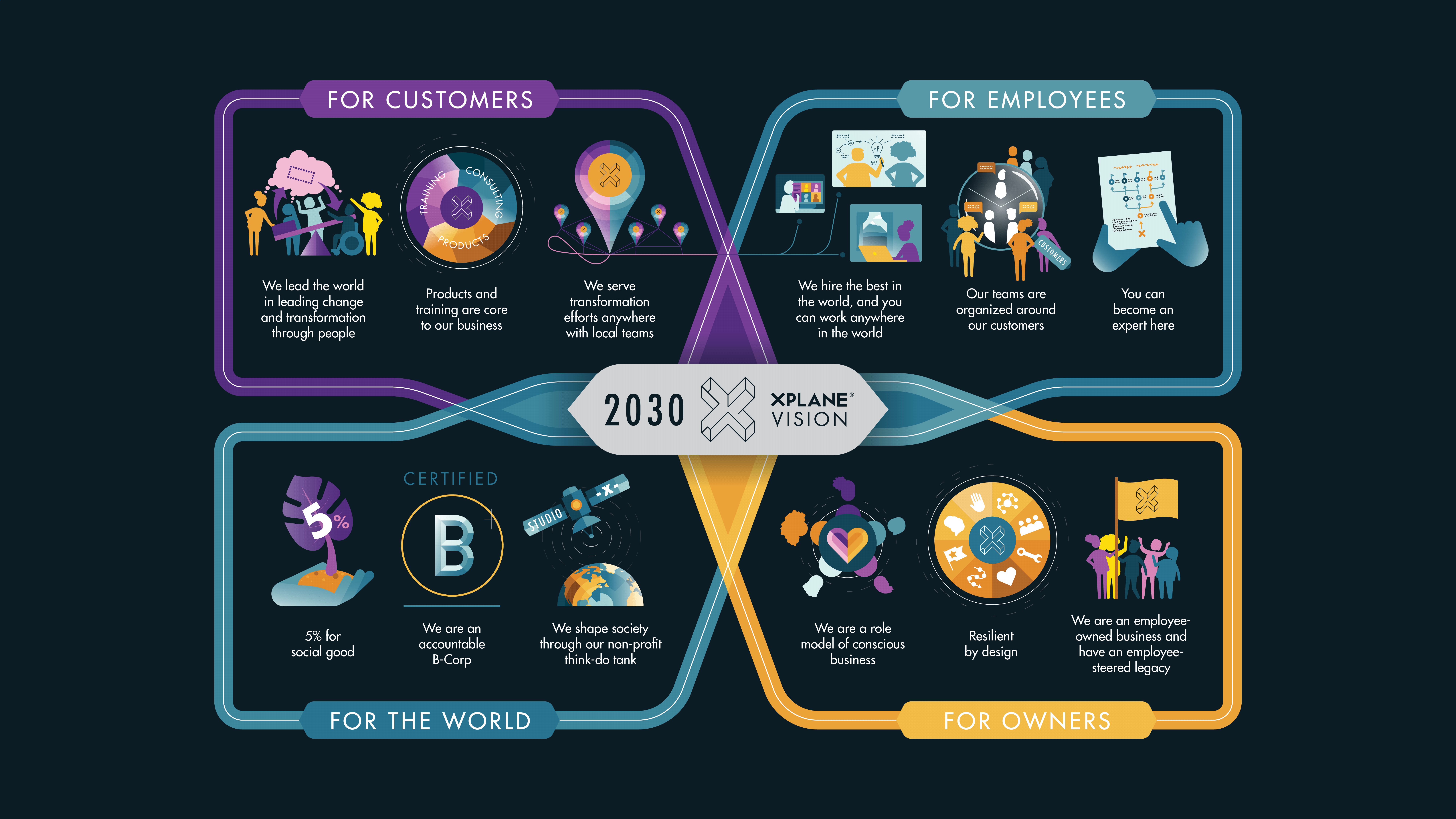In today’s world of unrelenting change, organizations and leaders that will thrive are those mindfully building core capabilities around change. Want to enhance your change leadership skills? Here are seven principles and five steps to help you lead change with finesse.
This blog post is a summary of our webinar Leading Change from the C-Suite: An Executive Toolkit to Lead Change and Transformation in Your Organization. We invite you to view the recording for expanded content.
In today’s business landscape, change is not only a constant—it’s accelerating. And leaders are feeling the impact.
The ability to successfully lead change will become a leader’s secret weapon in coming years.
Four Barriers to Change
Unfortunately, it’s not easy to lead change.
Approximately 80% of new strategic initiatives fail, and few executives are trained in professional change management techniques.
However, understanding the four most common barriers to change is a first step toward enhancing your ability to lead change:
- An unclear vision. Leaders tend to see clearly where they want to go, but if everyone doesn’t see the same destination as clearly as they do, they’re never going to get there.
- Disengaged people. Leaders rarely engage the people that need to change in the change process itself. Instead, they (unrealistically) expect people to jump from plan to action.
- Lack of skills. Sometimes it isn’t lack of belief in a change that keeps people from moving forward. Leaders need to equip people with skills and training in new ways of working to make change succeed.
- Little investment in activation. Leaders spend great sums of money and time developing strategies but invest little in bringing strategy to life. An organization can’t simply move from plan to action without involving its people in the process of change.
Think Like a Modern Organizational Leader
Why is it so important to engage employees in change?
It’s because modern organizations are more like organisms than machines and must be transformed from within.
Leaders need to persuade people that the new plan is better for the organization and for them and support their people through the process.
Getting People Onboard with Change
No matter the scope of change, the Activation Curve can help you understand what it will take to get people to understand a strategy, get aligned, adopt new behaviors, and move to action.

To move people from the bottom of the curve to the top, you must start with where they are today and determine where you would like them to be in the future.
The Activation Curve offers a fast way to break through the clutter of who needs to be involved in a change process and get clarity on where to start.
Seven Principles of Successful Change Leadership
Change in a modern organization is not a one-size-fits-all process.
You’ll need different approaches for different groups of people, and each group will move up the Activation Curve at a different pace.
At XPLANE, we’ve developed seven principles, or best practices, that are hallmarks of successful change leadership.
These principles will flex to the unique needs of groups in your organization. Dig into these principles to help people get unstuck and move to the next level of activation.
Principle 1: Make It Visual
If you can’t explain your vision on one page, it’s not clear to you—and it won’t be clear to your people.
A one-page visualization of your desired change allows you to clearly explain the desired future state and help others see the same future that you do.

Principle 2: Make It Measurable
This may seem obvious, but it’s critical to measure progress toward your desired change outcomes just as you would any business objective.
Measurement helps you know how far you are in the journey. And when you’ve arrived, it lets you know when and where you might need to change course, and it builds momentum and support for the initiative.
Principle 3: Make It People-Centered
Change happens through people.
Using empathy to understand the wants and needs of your people gives you critical intelligence on what it will take to persuade people to do something different than the way they used to do it.
Principle 4: Co-Create Solutions
Many leaders overlook the incredible value in engaging employees in developing solutions. Instead, they choose to craft plans in a management silo or, worse yet, outsource that thinking to consultants.
Co-creation is one of the strongest tools in your kit, and you can apply it at almost every touchpoint in your change program.
People support that which they create, so when you engage employees in developing solutions, they are more likely to support, advocate for, and more quickly adopt new ways of working.
Principle 5: Activate Your People
In addition to those you engage directly in co-creation, you need to think about other stakeholders who will need to change their ways of working—and mindfully design a program to activate them.
According to new research from McKinsey, most organizations engage about 2% of employees in active roles during a change.
Yet research indicates it takes 7% of employees to get to the tipping point where a change initiative succeeds.
To succeed at change, you need to create a “movement” in the literal sense, helping stakeholders understand the change, get aligned, and move to action together.
Principle 6: Establish a Governance System
No matter the scale of your change, you’ll want to create a governance system by empowering and holding a team accountable for converting insights into action.
Your governance system doesn’t have to be complex.
It could be as simple as a monthly one-on-one meeting or a small group that meets every quarter to track progress and course-correct as needed.
Principle 7: Make It Agile
As the saying goes, no plan survives first contact.
Anticipate this and build flexibility into your approach.
Ongoing measurement and management allow you to sense and respond to change and make course corrections that will ultimately get you to your destination.
A Five-Step Framework for Leading Change
Keeping the seven principles of successful change leadership in mind, you can use this simple five-step plan for giving your change program liftoff.
Step 1. Visualize the Future State
First, co-create with critical stakeholders a one-page visual that clearly depicts your vision.
You’ll want to share this in meetings or other interactions. Better yet, put it on the walls or intranet so everyone can see where the organization is headed.
Your visualization should generate conversation and enable people to start engaging with the change at hand.
- Recommended tool: Vision Map*
Step 2. Co-Create the Plan
Involve people in the “how” discussion. Present your vision and ask, “How might we achieve this?”
In all probability, multiple work streams will be required to successfully achieve your vision.
Assign the right stakeholders to each work stream team and ask them co-create an action plan. These people are close to work practices that may need to change and are likely to share insights and erase blind spots you might have as a leader.
In addition, these teams will also be more supportive of change because they’ve helped create the plan.
- Recommended tool: Initiative Tracker*
Step 3. Activate Your Team
For change to happen, you need a broad movement, so think of activation as an internal marketing campaign.
Who are your target customers and what communications, training, and tools do they need to move from Point A to Point B?
Remember, employees in today’s modern organizations have great agency to choose to support or not support a change.
Tilt the scale by investing in an activation program.
Ensure you have a clear case for change, communications that speak to the wants and needs of the different stakeholders in the organization, and provide learning opportunities and support to build skills for people to start working in new ways.
- Recommended tools: Who / Do Framework, Activation Building Blocks Cheat Sheet, Activation Curve, Activation Roadmap*
Step 4. Measure Progress
The route to change is never a straight path.
By putting clear definitions of success in place, you can measure progress along the change journey and help people see where they are and how far they need to go.
Start with a plan, but make sure you’re actively measuring progress so you know where to reallocate resources to make sure you stay on track.
- Recommended tool: Measurement System Worksheet*
Step 5. Sense and Respond with Course Corrections
Your measurement system and governance system together allow you to sense where you’re at and respond to course corrections.
Ultimately, sensing and responding will allow you to run an agile program and be more successful.
Obstacles that might have stopped a change program in the past are simply your next step and next decision point at which you can determine how to pivot to reach your destination.
- Recommended tool: Governance Planning Worksheet*
Arrival Requires Leader Orchestration
As a leader, your role is to ensure your team arrives at their destination.
This requires a lot of orchestration, but you don’t necessarily have to lead from the front at every step.
By applying the seven principles and working with the five-step framework, you’ll ensure your team has a clear destination, motivation to take the journey, and the tools and training needed to succeed.
And by making course corrections along the way, you’ll better adapt to inevitable changes, leading your organization with confidence toward a new way of working.
*These tools are available in XPLANE’s “Leading Change from the C-Suite: A Playbook for Executives.”
Want to Learn More About Leading Change?
Check out our suite of blog posts, resources, and learning opportunities below!
Get Our Leading Change Executive Playbook
We’ve designed our Leading Change from the C-Suite: A Playbook for Executives to be effective for programs of any size—from a singular process change all the way up to a global scale. We’ve included tools designed to be used alone or in groups that will shape your thinking and increase your confidence as you guide your change initiatives.
Read More
- Confidently Lead Your Next Change Initiative
- Strategy Execution Needs Human-Centered Design: Five Steps to Turn Plans Into Action
- Overcome Strategy Failure: Three Principles to Bring Your Strategy to Life
- The Secret to Bringing Your Strategy to Life
- How to Design a Strategy Execution Plan
Questions?
Finally, if you have questions about this webinar or leading change, don’t hesitate to reach out to us!
